|
Kambove District - Kambove West, Kamoya, Kamoya Sud, Kamfundwa, Shangolowe, MSesa, Kabolela |
|
|
Katanga, Dem. Rep. Congo |
| Main commodities:
Cu Co
|
|
 |
|
 |
 |
Super Porphyry Cu and Au


|
IOCG Deposits - 70 papers

|
All available as eBOOKS
Remaining HARD COPIES on
sale. No hard copy book more than AUD $44.00 (incl. GST) |
|
 |
The Kambove Principal open pit, adjacent Kambove West underground, Kamoya East, Kamoya West, Kamoya Sud II, Kamfundwa, Shangolowe, M'Sesa and Kabolela sediment hosted copper-cobalt deposits are located 25 km NW of Likasi, 130 km NW of Lubumbashi and 130 km ESE of Kolwezi, in Katanga Province of the Democratic Republic of Congo (DRC). These deposits are in the central part of the ~350 km long Congolese Copperbelt, part of the larger Central African Copperbelt that extends south into Zambia (#Location: 10° 52' 59"S, 26° 35' 56"E).
Kambove Principal is immediately to the SE of Kambove West/Ouest, while Kamoya is ~2 km to the west, and Kamoya Sud is 1 km SW of Kamoya. Kamfundwa is 7.5 km north of Kambove and Shangolowe is 2 km WNW of Kamfundwa. M'Sesa and Kabolela are 3.5 km north and ~14 km WNW of Kambove respectively.
Open pit mining was commenced on the outcropping southern flank of the Kambove deposit in 1959, and continued until 1965 (François, 2006). This mine was developed on the vertically dipping, southern limb of a large north verging syncline. From 1963 onwards, mining moved underground at Kambove West on the deeper part of the same limb. Total production at Kambove West until January 1973 was 10.92 Mt of ore at 5.68%. In 1978, mineralisation was discovered on the northern limb of the structure, where the orebody lies almost sub-horizontal at a depth of 400 to 500 m. Exploitation of this section of the deposit commenced in 1988, although the mine collapsed in the same year and mining ceased (François, 2006). Before its closure, the Kambove underground mine was producing at a rate of 1.5 Mt of ore per annum (Prasad, 1989). The Kamoya Sud II open pit mine was started in 1998. The Kabolela South deposit was mined between 1939 and 1945 by Union Miniere, to produce 0.44 Mt @ 4.84% Cu and 2.38% Co. Production from all of the mines in 2010 amounted to ~40 000 t Cu and 5000 t Co.
Regional Setting
For details of the regional setting of the Kambove district, the Central African/Congolese Copper Belt and the Lufilian Arc, see the Central African Copperbelt - Congolese/Katangan Copperbelt record.
Geology and Mineralisation
Mineralisation within the Kambove district is predominantly hosted within the Mines Subgroup of the Roan Group, part of the Neoproterozoic Katanga Supergroup.
The sequence, within the DRC, commences with the R.A.T. Subgroup, a massive to irregularly stratified detrital suite, often strongly hematite-rich due to the primary oxidising conditions during deposition (Cailteux et al., 2005). This unit was deposited during the first period of rifting within the Katanga Basin.
Subsequent evaporitic carbonate-rich sedimentary rocks of the Mines Subgroup were deposited at the beginning of the thermal sag phase, in shallow intratidal to supratidal environments and hypersaline lagoons, occurring as dolomitic shales and siltstones, which include relicts of stromatolites and algal reefs (Cailteux et al., 2005).
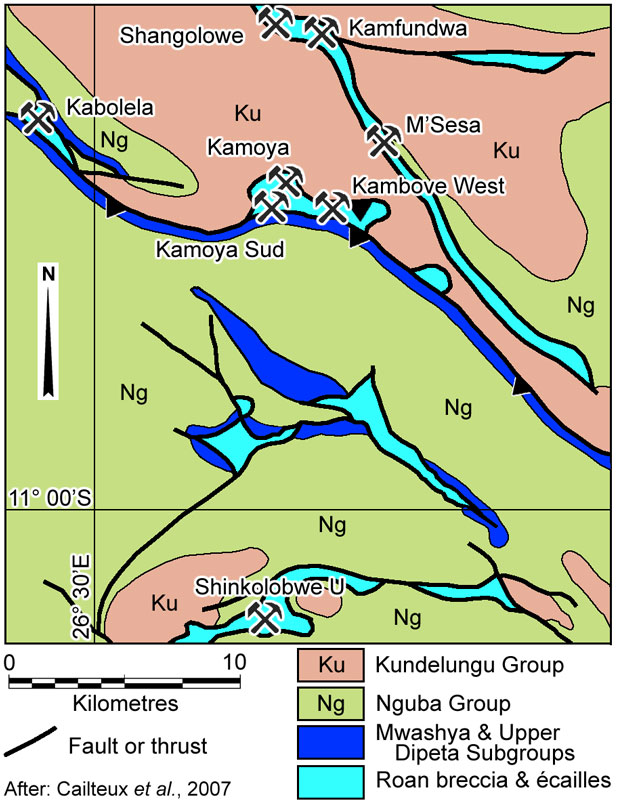 The overlying Dipeta Subgroup comprises argillaceous and siliciclastic beds at the base, often oxidised, overlain by evaporitic lagoonal deposits, stromatolitic carbonate units, and deeper water dolomitic shales and siltstones that formed in repeated regressive and transgressive sedimentary cycles, each beginning with siliciclastic deposits and ending with thinly bedded carbonates, similar to the sediments of the Mines Subgroup (Cailteux, 1994; Hitzman et al., 2012).
The overlying Dipeta Subgroup comprises argillaceous and siliciclastic beds at the base, often oxidised, overlain by evaporitic lagoonal deposits, stromatolitic carbonate units, and deeper water dolomitic shales and siltstones that formed in repeated regressive and transgressive sedimentary cycles, each beginning with siliciclastic deposits and ending with thinly bedded carbonates, similar to the sediments of the Mines Subgroup (Cailteux, 1994; Hitzman et al., 2012).
The uppermost Mwashya Subgroup consists of carbonaceous and dolomitic shales, capped by thin sandstones (Cailteux, 2007).
Renewed rifting had commenced during the late Dipeta Subgroup deposition, continued through the Mwashya Subgroup, and resulted in the Roan sediments being conformably overlain by the Nguba and Kundelungu Groups.
The early Kundelungu Group corresponds to the onset of basin inversion and the Lufilian Orogenesis (Batumike et al., 2006), and is overlain by the extensive, undeformed, flat lying, non-evaporitic, continental clastic molasse succession of the Plateaux Subgroup in the upper half of the group.
For a more detailed stratigraphic and structural description, see the Congolese Copperbelt record.
The Mines Subgroup is subdivided into the Kamoto, Dolomitic Shales and Kambove formations.
The Kamoto Formation, comprises the Grey R.A.T. (Roches Argillo Talqueuses), D.Strat. (Dolomies stratifiées) and R.S.F. (Roches Siliceuses Feuilleteés) members, which host the Lower Orebody, and the overlying, generally barren, R.S.C. (Roches Siliceuses Cellulaires). The regional stratigraphy and lithologies of these members are described in more detail in the Congolese Copperbelt record.
At Kambove West, the Grey R.A.T., D.Strat. and R.S.F. are a suite of light to dark grey dolomitic, clay-rich siltstones, although the Grey R.A.T. is lighter in colour and more homogeneous, while rocks from the D.Strat. and R.S.F. units are darker and well layered. There is some evidence within these units of small-scale slumping and fault structures, and differential compaction around nodules and disrupted bands and layers of both dolomite and quartz within the D.Strat. and R.S.F. units. All three members are crosscut by bedding normal veins of coarse white to pink dolomite. Irregular, fine veins of brownish and beige to white dolomite also frequently crosscut all former structures (Van Langendonck et al., 2013).
The mineralisation of the Lower Orebody at Kambove West comprises disseminated chalcocite within the host rock, chalcocite concentrated along the bedding and in bedding-parallel layers. Coarse chalcocite crystals are found at the margin of the coarse crystalline dolomite veins, while pink cobaltoan dolomite replaces dolomite, especially the white, coarsely crystalline variant (Van Langendonck et al., 2013).
Rocks from the R.S.F. are the most hypogene mineralised of the three Lower Orebody hosts, while the Grey R.A.T. is the least. The Grey R.A.T. is very similar to, and conformably and gradationally overlies the R.A.T. Subgroup, although it is grey and pyritic, rather than red/lilac and hematitic. Locally, the Grey R.A.T. is strongly brecciated, and forms one of the main components of the Bréche Hétérogène (or heterogeneous breccia). The Bréche Hétérogène within the Grey R.A.T. consists of mm- to cm-scale fragments of greyish dolostone, in a matrix of dolomite and quartz, but also contains a significant amount of chalcocite and iron oxides/hydroxides, i.e., goethite and hematite. Some fragments have a red hue, especially at the margins, due to oxidation (Van Langendonck et al., 2013).
In a drill hole studied by Van Langendonck et al. (2013), cutting through the Kamoto Formation at a depth of ~250 m below the surface, all three members hosting the Lower Orebody are strongly altered/weathered and affected by supergene processes. The Grey R.A.T. is intensely altered with 8 to 9.5% Cu, occurring mainly as chalcocite spots, with lesser disseminations and veins. Chalcocite also occurs as disseminations, and in lenses, layers and veins at the base of the D.Strat., and in the silicified remains of stromatolites, and then in fractures stratigraphically higher in the same unit, followed by a zone of large nodules and bands of massive chalcocite, defining a peak of 6.5% Cu. Stratigraphically above this zone, copper grades then diminish in an interval with intense fracturing accompanied by large quantities of iron oxides/hydroxides suggesting supergene leaching. Strong enrichment was observed in the overlying R.S.F. as the R.S.C. is approached, with grades of up to 17% Cu locally in intensely silicified and altered carbonaceous shale, occurring as a massive replacement of the host rock by chalcocite.
The R.S.C. member is heavily altered, silicified and porous where deeply weathered, with little remaining of the protolith, a clay-rich dolostone with stromatolites (Cailteux et al., 2005). It contains abundant large spots to thick veins of very coarse white dolomite and is locally brecciated, often in combination with dissolution and other alteration features. Alteration is also characterised by a red coloration due to oxidation of the rocks. Although the R.S.C. is usually barren in most DRC deposits (Cailteux et al., 2005), supergene chalcocite is abundant in this member at Kambove West, occurring mainly as irregular spots, in nodules and veins, and as massive replacements in altered zones. The R.S.C. is variably fractured and brecciated, and in general, has been intensely oxidised/altered (iron oxides/hydroxides) and subjected to dissolution, accompanied by silicification, to depths of >300 m below the surface in the south limb, well below the normal base of oxidation. A very distinct, late phase, of pink cobaltoan dolomite or spherocobaltite is evident, which is replacive, and can also be found infilling pores and vugs. Little or no traces of carrollite are evident (Van Langendonck et al., 2013).
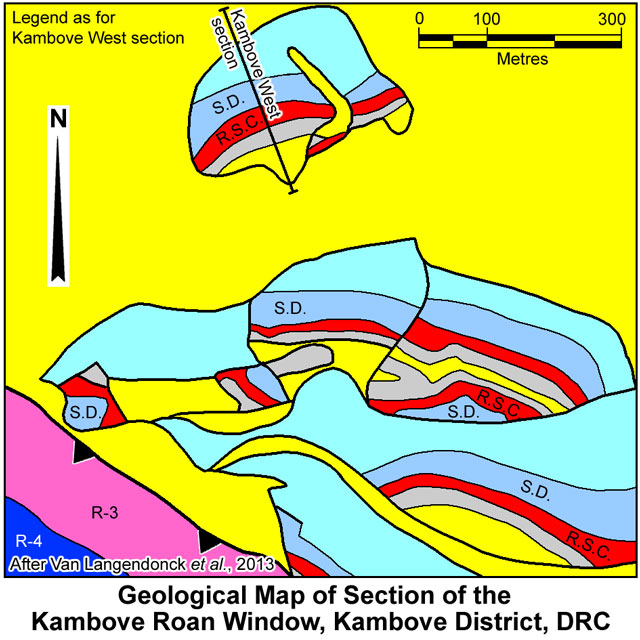
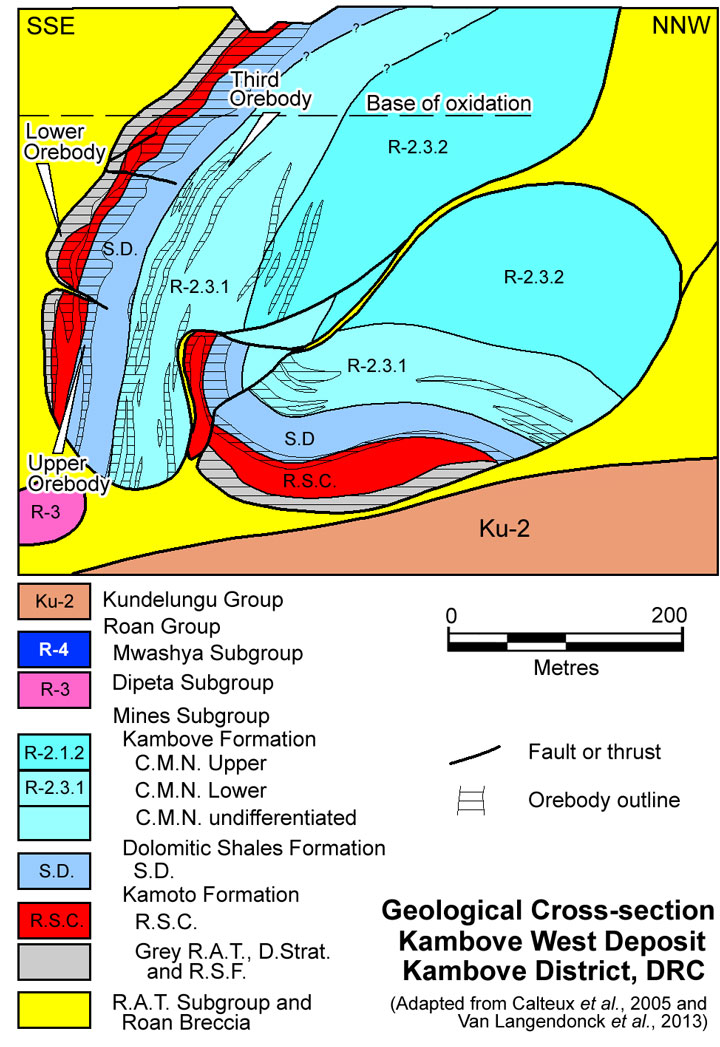
The Dolomitic Shales Formation, which overlies the Kamoto Formation, commences with the S.D.B. (Schistes Dolomitiques Basal; or S.D.-1a) member which hosts the Upper Orebody. This member is composed of finely laminated, grey, dolomitic shales that contain abundant nodules, lenses and bands of dolomite, quartz and ore minerals. Strong differential compaction around these nodules, gives the rock a wavy appearance. Organic-rich black shales are locally typical of this member. Minor veining parallel to layering and some irregular veins of dolomite and quartz are observed (Van Langendonck et al., 2013).
Mineralisation within the Upper Orebody at Kambove occurs as disseminations, spots, nodules and in bands, with ore minerals which include chalcopyrite, bornite and chalcocite. The latter is particularly abundant as impregnations in the black shales, and in altered zones as large irregular spots and veins. No relict carrollite or cobaltoan dolomite were noted. The mineralogy is relatively simple, with few indications of alteration and remobilisation (Van Langendonck et al., 2013).
The deep oxidation and supergene enrichment seen in the adjacent R.S.C. decreases rapidly, as does the copper grade, which is also reflected in the mineralogy and lithologies. Chalcocite, bornite and chalcopyrite are found in nodules, veins and spots at the base of the S.D.-1a member, passing into a zone of bornite and chalcocite as disseminations, lenses, layers and veins, beyond which only chalcopyrite is found, as disseminations, lenses, layers, nodules and veins. When the copper grade diminishes to <1%, only disseminated chalcopyrite is evident. The base of the S.D.-1a member includes a carbonaceous shale with anhydrite pseudomorphs as lenses and layers in the silty bands. This passes up into dolomitic shale which is pale and not as carbonaceous. At the top of the S.D.-1a, there is a transition from a dolomitic shale to a pale dolomitic siltstone or even massive dolostone with some chalcocite lenses, layers and disseminations carrying variable copper grades (Van Langendonck et al., 2013).
The overlying members, comprising: S.D.-2a - pale, massive dolostone, with a distinct red coloration due to disseminated hematite; S.D.-2b and c - grey, silty, laminated dolostone, locally brecciated; S.D.-2d - dark carbonaceous shale, overlain by dolomitic shale to siltstone with abundant red hematite colouration; S.D.-3a - laminated dolostone, with a red hematitic alteration. These members are principally finely laminated dolomitic shales, which are usually lighter in colour, although dark organic-rich shales are locally evident. Nodules, lenses and bands of the type seen in S.D.-1a are largely absent from these stratigraphic levels onwards, although layer parallel dolomite veins are abundant, as well as layer normal and irregular veins, some of which show evidence of differential compaction. Elsewhere, an irregular silicification front, and bleached or brecciated zones are observed (Van Langendonck et al., 2013).
Some bornite and chalcocite occur in S.D.-2a. The S.D.-2b+c and -d members, contain much less copper, with local peaks of up to 1% Cu and as much as 4% Co, whilst pyrite, with minor chalcopyrite and bornite comprise the bulk of the mineralisation, occurring as disseminations and occasionally also as veins and layers. Locally, massive replacement and strong enrichment in chalcocite is observed, accompanied by a reddish colouration due to hematite or goethite, although a distinct red alteration is spread throughout the S.D.-2a and S.D.-2b+c members. At the top of the S.D.-2b+c, chalcocite is observed, as disseminations and in lenses and layers. Sub- to marginally economic mineralisation occurs in the organic-rich, black, carbonaceous, metapelitic horizons of S.D.-2d and S.D.-3b. At the base of the S.D.-3a member, some chalcopyrite is found disseminated and in lenses and layers. Some cobalt peaks (up to 0.4%) can be distinguished in the upper part of the S.D. Formation, associated with carrollite, whilst cobaltoan dolomite seldom occurs (Van Langendonck et al., 2013).
At depths of ~250 m and shallower, bornite, chalcocite, malachite and abundant iron oxides/hydroxides can be observed in the upper part of the S.D.-2d, as well as in the adjacent S.D.-3a, while a zone of massive replacement by chalcocite at the base of the S.D.-3a causes a small but distinct elevation in the copper grade (~2%) (Van Langendonck et al., 2013).
The Kambove Formation, also known as the C.M.N., (Calcaire á Minerai Noir), is divided into a Lower and an Upper C.M.N. (R-2.3.1 and R-2.3.2), which comprise grey layered to mainly massive dolomite, and includes dark, organic rich beds, and relicts of algal mats, similar to the R.S.C. The Lower C.M.N. (R-2.3.1) hosts the Third Orebody position. Quartz-dolomite veins are both parallel and normal to bedding, and irregular. Fracturing and brecciation are common. Alteration is often
very abundant, occurring as light grey to beige, finely crystalline dolomite, as is a red colouration due to iron oxides/hydroxides (hematite and goethite). Significant pink cobaltoan dolomite or spherocobaltite occurs, particularly in the vicinity of large spots of carrollite. Chalcocite is present in small to large spots, veins and replacing carrollite. Native copper, malachite, pseudomalachite, heterogenite and manganese oxides are present (Van Langendonck et al., 2013).
Structure
The sequence described above has been significantly disrupted by halokinetic deformation related to remobilisation of halite-evaporite units within the R.A.T., Mines and Dipeta subgroups, producing the Roan Breccia, and by the subsequent 560 to 530 Ma Lufilian Orogeny.
The mineralised Roan Group sedimentary rocks are exposed in a series of faulted anticlinal cores, and as thrust slices underlain by Kundelungu Group rocks, commonly unit Ku-2.1, and overlain by rocks of the Kansuki Formation, the uppermost unit of the Roan Group Dipeta Subgroup, which is in turn overlain by the Mwashya Subgroup, and the Grand Conglomérat, the basal unit of the Nguba Group. The anticlinal structures are north- to NE-verging and are cut by generally axial plane parallel north- to NE-verging thrust faults. The Roan Group rocks also occur as isolated diapirs of pre-Kansuki Formation Roan Group rocks intruding Nguba Group sequences.
This structural activity has produced a series of long, generally parallel, NW-SE trending slivers of Roan Group sedimentary rocks which locally swell or pinch out. There are two main slivers hosting ore in the Kambove district. The first is the main regional Kambove Anticline, which includes the Shituru and Kakanda deposits, 25 km to the SE, and ~30 km to the NW respectively. In the Kambove district, this sliver encloses the Kambove-Kamoya and Kabolela deposits. The most important ore development, Kambove-Kamoya, corresponds to a section of the structure that locally trends east-west, before resuming the overall NW-SE alignment seen to the NW and SE.
The second is the similarly NW-SE trending Sesa Extrusion Fault, which passes ~2 km to the NE of Kambove, and encompasses the Kamfundwa, Shangolowe and M'Sesa deposits, but does not include a 'dogleg' like the Kambove Anticline. Extrusion faults, such as this are not interpreted to be associated with anticlines like the Kambove structure, but are deep fault zones that cut the strata at an acute angle, providing a weakness that is exploited by the diapiric rise of lighter, evaporite-rich Roan Group rocks. Francois and Coussement (Unpub., 1990), suggest that these extrusion faults may be related to the D2 strike-slip Monwezi event, in contrast to the north- to NE-vergent thrusted structures such as the Kambove Anticline, which is interpreted to be related to the D1 compressive Kolwezi event. For more detail on these structural events, see the Congolese Copperbelt record
The pre-Kansuki Formation Roan Group rocks are almost invariably broken into megabreccias, composed of a jumble of blocks or écailles (French for 'fish-scales', a local structural term for tabular tectonic megabreccia blocks) of Mines Subgroup rocks that are up to 250 m thick and several hundred metres to 1.5 km in length and down-dip extent, encased within a matrix of R.A.T. Subgroup blocks, and Roan Breccia, largely composed of heterogeneous, comminuted R.A.T., Mines and Dipeta subgroup rocks. Internal disruption within écailles or between immediately adjacent écailles are occupied by monomictic breccias composed of the neighbouring lithologies (see the Congolese Copperbelt record for a more detailed description).
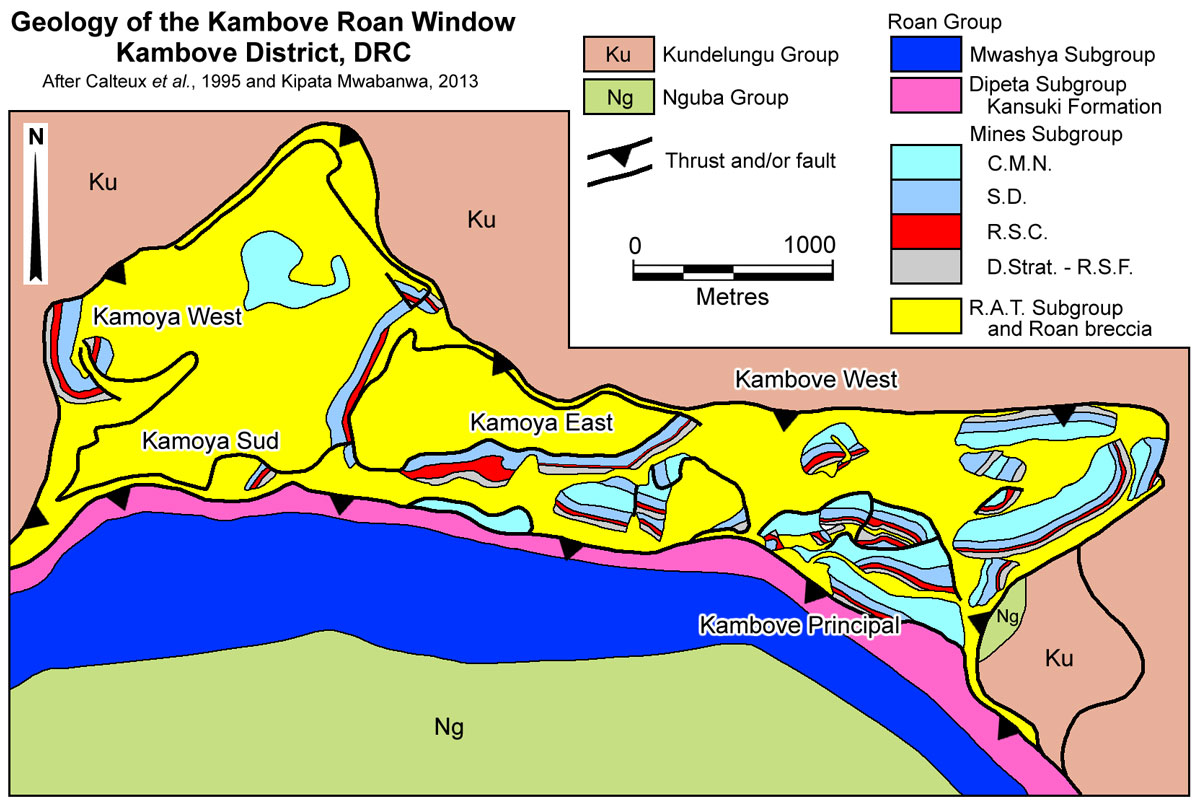
There are three main megabreccia windows in the Kambove district, as follows:
Kambove Window - a large, east-west elongated, Roan megabreccia, ~6 km long x 0.7 to 1.8 km wide, composed of more than 20 écailles within a matrix of R.A.T. and Dipeta subgroup rocks. It is overlain in the south, by a north-vergent thrust sheet of south-dipping Kansuki Formation, Mwashya Subgroup and Grand Conglomérat Nguba Group rocks, the Kambove Overthrust (François, 2006) and underlain to the north, by a major, north-vergent thrust-detachment that places the Roan Window over the younger Kunpelungu unit Ku-2.1. This structure passes under the Kambove Overthrust to the east and west, marking the extremities of the window. The Kambove Window occurs in an irregularity in the regional, overall NW-SE trending Kambove Anticline, where the structure locally trends east-west.
A cluster of écailles in the SW of the window host the ore exploited by the Kambove Principal open pit, while a smaller block to its NW hosts the Kambove West deposit. The Kamoya deposits occur in two separate syncline fragments (Kamoya East and Kamoya West) separated by a central, fault bounded, north-south trending écaille of largely un-mineralised Mines Group rocks. The rich Kamoya Sud deposit is within a small écaille to the south.
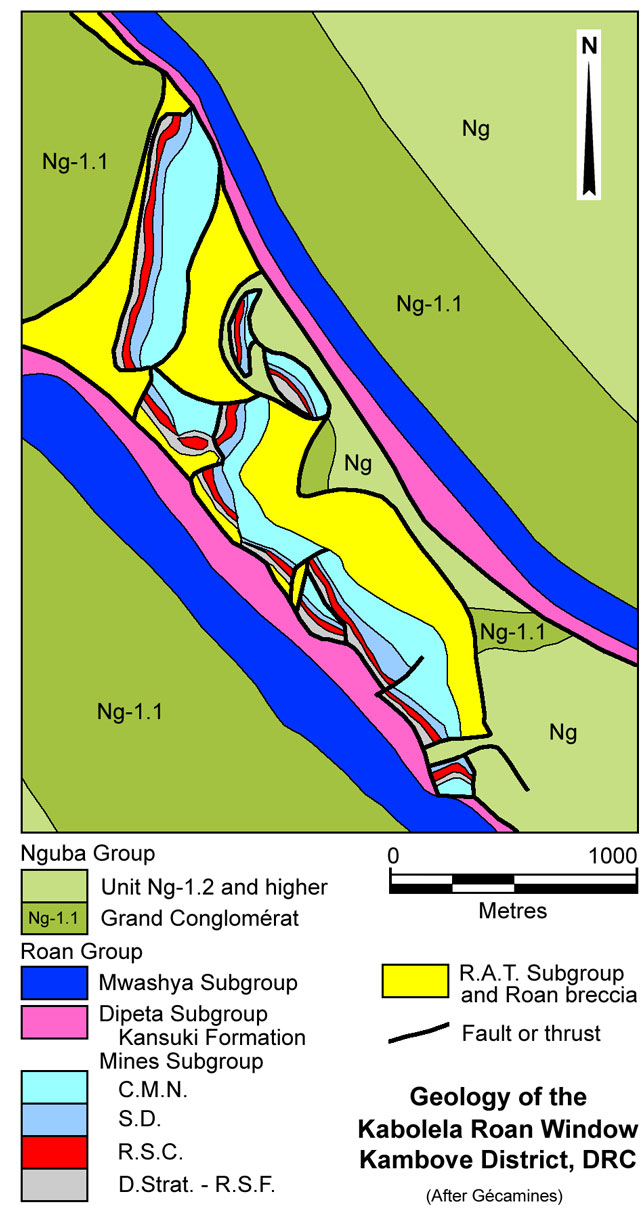 Kabolela Window - which is ~14 km to the WNW of Kambove, is ~3 km long x 500 to 1000 m wide, bounded to the NE and SW by steep reverse faults to thrusts. The megabreccia, which contains more than 10 écailles, is overlain by the Kansuki Formation rocks above a detachment surface, passing out and up on both sides into Mwashya Subgroup and Grand Conglomérat Nguba Group rocks. The main Kabolela North deposit is hosted by the northernmost large écaille, while Kabolela South is in the écailles to its south.
Kabolela Window - which is ~14 km to the WNW of Kambove, is ~3 km long x 500 to 1000 m wide, bounded to the NE and SW by steep reverse faults to thrusts. The megabreccia, which contains more than 10 écailles, is overlain by the Kansuki Formation rocks above a detachment surface, passing out and up on both sides into Mwashya Subgroup and Grand Conglomérat Nguba Group rocks. The main Kabolela North deposit is hosted by the northernmost large écaille, while Kabolela South is in the écailles to its south.
Kamfundwa Window - ~7.5 km north of Kambove, within a 'kink' in the Sesa Extrusion Fault. It covers an area of ~1500 m long x 200 to 600 m wide, and has been shown to extend to a depth of 260 m (Infomine, 2013). It contains 7 écailles of mineralised Mines Subgroup rocks, hosting the Kamfundwa and Shangolowe deposits. The écailles also include brecciated stromatolitic laminated talcose dolomites of the C.M.N unit, in faulted contact with Kundelungu Group rocks, separated by a monomictic breccia of R-1 Subgroup (R.A.T Lilas). Two types of C.M.N. breccia are identified, some of which have been subjected to intense supergene-oxide mineralisation. The first of these breccias is composed of angular, elliptic, uncemented, rock fragments, that are generally arranged with their long axis vertical. This breccia contains massive malachite, chrysocolla and black oxides. The second C.M.N. breccia is further subdivided into a variety that retains its original stratification (striking NNE-SSW to ENE-WSW) and another that is strongly fractured, with virtually no stratification, and no mineralisation. Both the mineralised and non-mineralised breccia are found in transverse fault zones. These fault zones are related to the core of the folded Roan Group écailles (Kipata Mwabanwa, 2013).
Paragenesis
The paragenesis of ore formation is split in three stages by Van Langendonck et al. (2013): i). sedimentary to early diagenetic; ii). diagenetic to possibly, low grade metamorphic; and iii). supergene mineralisation.
A subdivision into six phases within this broader framework, reflecting different gangue and ore minerals associations, is also proposed by Van Langendonck et al. (2013), as follows:
Phase I is dominantly composed of very fine-grained dolomite within the dolomitic siltstones and shales, accompanied by fine-grained pyrite and anhydrite nodules, lenses and layers, apparent now as pseudomorphs. The mineralised and altered Mines Subgroup host rocks were deposited in a sabkha to lagoonal environment (e.g., Cailteux, 1983), with the shaly units of the S.D. formations laid down in lagoons, whilst stromatolites and algal reefs grew in intratidal zones.
According to Van Langendonck et al. (2013), the evaporite derived nodules and layers, together with organic matter, allowed bacterial sulphate reduction to occur during diagenesis in this and succeeding phases, to release bicarbonate and H2S. The bicarbonate directly caused the precipitation of dolomite, whilst the reduced sulphur from the H2S reacted with the iron oxides to initially form pyrite (e.g., Muchez et al., 2008) during early diagenesis, explaining the observed association of dolomite and sulphides in the pseudomorphic anhydrite lenses and layers, and in the outer parts of the nodules. The production of H2S, made sulphur available beyond the anhydrite lenses, layers and nodules and allowed sulphides to form in veins and as disseminations in the host rock during later phases. These reactions also resulted in the release of hydrogen-ions, significantly lowering the pH. At a low pH, the solubility of silica is limited and authigenic quartz precipitated in the core of the nodules and also replaced dolomite.
Phase II accompanied continued diagenesis, and consists of quartz, dolomite and sulphides, the result of dolomitisation, veining and silicification, with dolomite and sulphides precipitated prior to quartz, although no phase II quartz veining is evident. This represents the first main stage of mineralisation.
During this phase, additional metals (Cu-Co) were introduced by a hydrothermal fluid, transmitted through the porous R.S.C., to interact with the sulphate and organic matter (as described above) and precipitate dolomite and silica in particular in the R.S.C., but also some sulphides, and dolomite, silica and sulphides into the adjacent strata (the Grey R.A.T., R.S.F and D.Strat. below, and S.D. above). Pyrite, chalcopyrite, bornite, carrollite, digenite and chalcocite were progressively precipitated as copper was introduced, combining with the available sulphur, to produce an outward transition from chalcocite in the outer R.S.C., through bornite and chalcopyrite, to an outer zone of pyrite in the S.D.-3. Virtually all of the copper sulphides in the Lower Orebody were converted to chalcocite, although the R.S.F., adjacent to the R.S.C. is the most mineralised of the three members, while the Grey R.A.T. is the least. Locally, a reverse trend is evident, where chalcocite, digenite and bornite are partly replaced by chalcopyrite, which is thereafter replaced by pyrite (possibly due to an Fe-rich, Cu-Co-poor hydrothermal pulse). Replacement of early diagenetic pyrite by Cu-Co sulphides is observed, implying it was, at least part, an intermediary sulphur source (Dewaele et al., 2006). Very strong enrichments in Cu occur in carbonaceous zones, particularly in carbonaceous dolomites or dolomitic shales within or close to the R.S.C.
Phase III took place during late diagenesis or low-grade metamorphism and represents a second main mineralisation stage, overprinting phase II. The bulk of the hypogene ore formation occurred during diagenesis, before permeability was occluded, although replacement controlled by cleavage planes and along fractures and veinlets can be observed locally.
Silicification (as coarse grained and sub- to euhedral quartz crystals), dissolution and quartz veining preceded dolomitisation and dolomite veins, and associated sulphides. The antecedent dissolution allowed the dolomite III crystals to grow freely. This fluid further enriched the host rock in Cu and Co by precipitating carrollite, chalcocite and minor digenite. The previous veins, lenses, layers and nodules are often recrystallised, although new veins were also formed. Much of the ore is contained within veins, with grades, in general, proportional to the degree of veining.
Phase IV includes minor dolomitisation with the development of a fourth, brownish, generation of dolomite in a few veins, occurring as distinct overgrowths and veins crosscutting the previous generations, but no replacement. Like the previous two pulses of dolomitisation, dolomite IV is well zoned. Although this generation is thought to be of hypogene origin, no mineralisation is associated with the dolomite. The exact timing of this dolomite generation remains unclear. No quartz was deposited.
Phase V accompanied supergene mineralisation, and is reflected by fine-grained drusy replacive dolomite and silica in voids after dissolution which took place throughout the period of supergene modification. The voids are often partly filled with drusy dolomite V (and possibly VI), fine silica and/or significant quantities of chalcocite and iron oxides, precipitated as spots, veins and even as a massive replacement of the host rock. Cobalt seems to be mobilised and substituted in dolomite to form cobaltoan dolomite and spherocobaltite. Metals were reprecipitated as oxides (mainly malachite) above the redox boundary and sulphides below.
Supergene chalcocite and associated alteration is reflected by replacement of the rims of hypogene ore minerals by chalcocite, irregular chalcocite spots and veinlets in altered zones with dolomites V and VI, and the orthorhombic microtexture in chalcocite. Spots of native copper and malachite also indicate supergene processes, as is the association of chalcocite with iron oxides/hydroxides, due to H+ being released by the precipitation of secondary sulphides, causing the pH to decrease to ~3.5. At this pH, goethite and hematite are preferentially formed by the breakdown of ferrihydrate (Ague and Brimhall; 1989; Alpers and Brimhall, 1989). These styles of mineralisation and alteration typically occur in or near the porous R.S.C. and in breccia zones within and marginal to the écailles, which could have acted as fluid conduits, especially in the southern, near vertical limb of the Kambove West syncline, where the R.S.C. is optimally orientated to transmit supergene fluids to deeper zones.
Phase VI is characterised by a more intense dissolution and oxidation of the previous minerals, with small spots of pseudomalachite, heterogenite and manganese oxides. Spherocobaltite and cobaltoan dolomite (dolomite VI) are also interpreted to be a result of supergene processes. The cobalt is interpreted to have been released when carrollite was dissolved at the expense of chalcocite formation. The released Co3+ is not stable (Craig et al., 1979) and will be reduced to Co2+, which substitutes in dolomite. Partial substitution, forms cobaltoan dolomite, while complete substitution results in spherocobaltite.
Resources
Total pre-mining resources at these mines are estimated as follows, after Wilson et al. (2010), "Relational Database of Sediment-Hosted Copper Deposits, Resources, and Production in the Central African Copperbelt, Democratic Republic of the Congo and Zambia; USGS Scientific Investigations Report 2010-5090-J". Historically, a cut-off grade of 3 to 4% Cu has been used for orebody delineation at the Kambove West deposit (Cailteux, 1983; Gécamines, UMHK):
Kambove Principal - 14.04 Mt @ 9.09% Cu;
Kambove West - 32.90 Mt @ 5.52% Cu, 0.30% Co;
Kamoya - 10.00 Mt @ 2.70% Cu, 0.45% Co;
Kamfundwa - 26.80 Mt @ 2.72% Cu, 0.20% Co;
Shangolowe - 25.00 Mt @ 8.00% Cu;
M'Sesa - 8.00 Mt @ 5.90% Cu, 0.21% Co;
Kabolela North and South - 11.70 Mt @ 2.31% Cu, 0.50% Co.
TOTAL ~128 Mt @ 5.3% Cu.
Information in this summary is predominantly derived from Van Langendonck et al., 2013 (see citation below).
The most recent source geological information used to prepare this decription was dated: 2013.
This description is a summary from published sources, the chief of which are listed below.
© Copyright Porter GeoConsultancy Pty Ltd. Unauthorised copying, reproduction, storage or dissemination prohibited.
|
|
|
Selected References:
|
Van Langendonck S, Muchez P, Dewaele S, Kaputo Kalubi A and Cailteux J, 2013 - Petrographic and mineralogical study of the sediment-hosted Cu-Co ore deposit at Kambove West in the central part of the Katanga Copperbelt (DRC): in Geologica Belgica v.16 pp. 91-104
|
|
Porter GeoConsultancy Pty Ltd (PorterGeo) provides access to this database at no charge. It is largely based on scientific papers and reports in the public domain, and was current when the sources consulted were published. While PorterGeo endeavour to ensure the information was accurate at the time of compilation and subsequent updating, PorterGeo, its employees and servants: i). do not warrant, or make any representation regarding the use, or results of the use of the information contained herein as to its correctness, accuracy, currency, or otherwise; and ii). expressly disclaim all liability or responsibility to any person using the information or conclusions contained herein.
|
Top | Search Again | PGC Home | Terms & Conditions
|
|